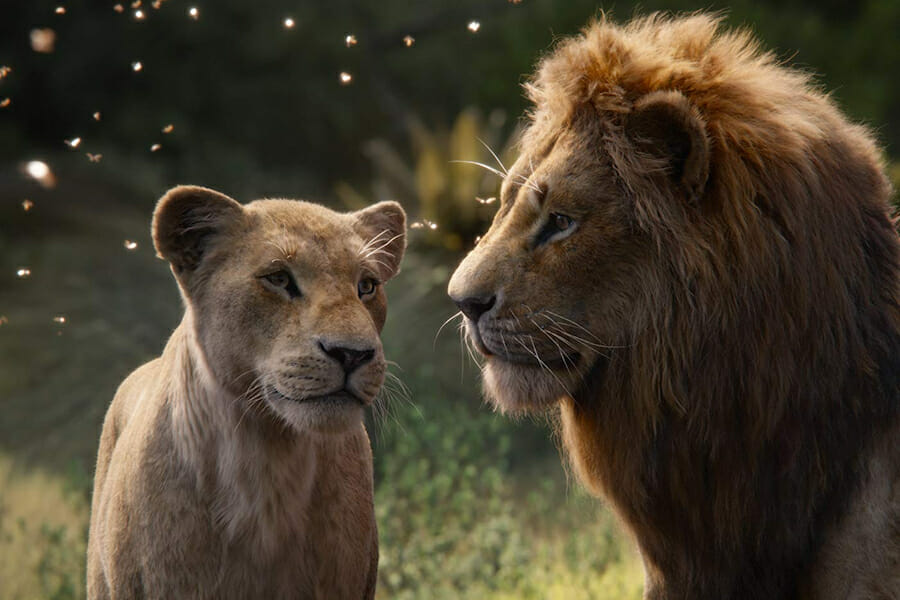
‘The Lion King’ Review
If you have come here to read yet another take on how this next-gen The Lion King remake of a beloved film doesn’t bring anything new to the story, you’ve come to the wrong place. I love cinema as an art form, and when analyzing a movie, I typically look for the good and enjoyable, rather than focusing on every element I might be able to criticize…never forgetting that the onscreen presentation is the culmination of work performed by many dedicated people, so that I might sit back in a comfy seat within the confines of an air-conditioned theatre and be entertained for a couple of hours. And entertained I was.
It only takes a few moments for the awe to set in. The graphics are at times so realistic that kids may actually believe animals can talk. More than once, the fur of an animal or the splash of the river reminded of a National Geographic program with ultra-high definition photography. So let’s clear up something right now. This has been labeled as a “live action” remake of the animated classic from 1994. You should know, even if your eyes tell you otherwise, that there is nothing “live” in the film. Instead, everything you see on screen is computer-animated. No, the lions and elephants aren’t real, nor are the trees or distant mountains. The look of the film is as revolutionary as 1995’s Toy Story. We had never seen animation like that then, and we’ve never before seen computer effects like this. What is familiar are two early songs, “The Circle of Life” and “I Just Can’t Wait to be King.”
Of course, neo-realism can be admired only as a technical achievement when we are discussing a movie in which lions talk and warthogs sing. So while we marvel at the technical achievement, let’s not lose sight of the story…what made the original so popular and beloved 25 years ago. Although it’s approximately a half-hour longer than the original, this one is exceedingly close to a scene-for-scene remake. Only minor tweaks will be noticed, mostly in the demeanor of Scar and the banter between Pumbaa and Timon – each actually improving on the first film. What remains is the coming-of-age story that will now touch many new hearts and minds.
Kids will be immediately entranced with the cubs, Simba and Nala, voiced by JD McCrary and Shahadi Wright Joseph (the daughter in Jordan Peele’s US), and with Zazu (voiced by John Oliver), the goofy and comical bird tasked with keeping an eye on the two adventurous youngsters as they get themselves into trouble. James Earl Jones (now 88 years old) reprises his iconic voice role as the wise Mufasa, and Alfre Woodward voices Sarabi, the pride’s leading female. Chiwetel Ejiofor is excellent as the bitter Shakespearian villain Scar, but I couldn’t help but wish Jeremy Irons had returned for this interpretation of the jealous and power-hungry brother of Mufasa.
The energy level jumps once Simba meets Pumbaa the warthog and Timba the meerkat. Seth Rogen and Billy Eichner take the comedy routine to a new place, and we can only assume much of their banter is off-script. Kids may not get every joke, but they are sure to respond to this odd couple. Donald Glover and Beyonce voice the grown Simba and Nala, and both are outstanding – especially with their singing (no surprise there). Nala’s role is expanded a bit…as expected when you cast Queen Bey. Her original song “Spirit” is included but it’s her duet with Glover on “Can You Feel the Love Tonight?” that is a real musical standout.
Director Jon Favreau has been in the chair for such hits as Iron Man (2008), and Elf (2003), and he was also behind Disney’s live-action remake of The Jungle Book (2016). The writing credits belong to Jeff Nathanson (Catch Me If You Can, 2002) for the screenplay, Oscar winner Brenda Chapman (Brave, 2012) for the story, and Irene Mecchi, Jonathan Roberts, and Linda Woolverton for the characters. The latter three were among the 28 writers credited for the 1994 version. Also back is composer Hans Zimmer, who won an Oscar for his 1994 score, and songwriters Elton John and Tim Rice, also Oscar winners for their 1994 song, “Can You Feel the Love Tonight?”
The beloved 1994 version didn’t win the Oscar for Best Animated Feature film because the award didn’t exist until 2002; however, it did spawn the 1997 Broadway smash musical. This more realistic version is rightly rated PG rather than G, as some of the scenes are likely to be a bit intense for younger viewers. It’s important to remember that this version is meant to bring Simba’s story to a whole new generation – it’s not meant to replace the 1994 version for those who were kids when it came out so many years ago. The story and characters, while familiar to those age 30 and up, will be a whole new viewing experience for today’s kids. So while we may prefer the 1994 animated version, kids today will likely be enthralled by this updated look. And we all better get used to it, because Disney has 18 more “live action” remakes in the works (some of which will actually be “live” action).

